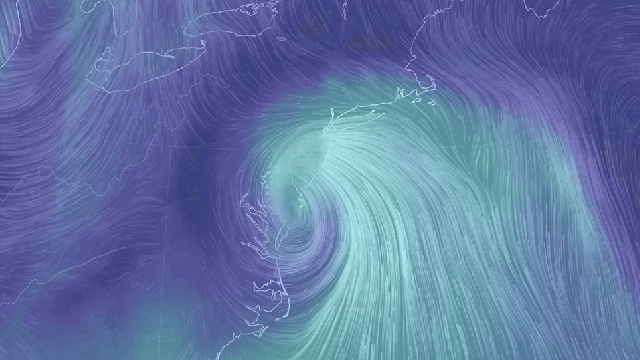Tropical Storm Fay formed on Thursday. It’s the sixth storm of the season and breaks yet another record in a season also teeming with them. Oh, and it’s also going to make for a really garbage weekend from the Mid-Atlantic to the Northeast.
The National Hurricane Centre declared Fay a storm late on Thursday afternoon after Hurricane Hunter aircraft reconnaissance. Atlantic hurricanes are named in alphabetical order, and that makes Fay the earliest-forming “F” storm we have in the records dating back to the 1800s. Which eff.
To recount the wackiness that’s transpired so far, two tropical storms formed way ahead of schedule.
Fay formed extremely close to land (similar to fellow freak Tropical Storm Bertha in late May), and its outer bands of rain are already near the North Carolina and Virginia coast. Hurricane Hunter aircraft observed winds around 72 km/h, a bit above tropical storm strength. Warmer than normal ocean temperatures — a hallmark of climate change — along the Eastern Seaboard could help add fuel to Fay, though the storm is forecast to stay at tropical storm strength.
Things will deteriorate as the storm climbs the Mid-Atlantic on Thursday night into Friday and then makes landfall somewhere that is likely to be between New Jersey and Connecticut late on Saturday. Up to five inches of rain could fall and heavy downpours are possible. Flash flood watches are in effect from Virginia to Massachusetts. The storm will also bring rain to northern New England and Canada even as it weakens into a tropical depression. Oh, and you can expect a wave of swampy humidity to pour into the region already dealing with a stifling heat wave in an added bonus for anyone who wants to know what it’s like to live in an armpit.
Atlantic hurricane season was already forecast to be active, and it’s certainly delivering so far. Fay comes after a brief respite in June when a huge Saharan dust plume temporarily put a damper on storm formation thanks to the drying effect it had on the atmosphere. Now, we’re right back in it. The National Oceanic and Atmospheric Administration’s forecast calls for up to 19 storms, including up to six major hurricanes. There are also growing signs that the forecast for an active season could be all too accurate, unfortunately.
[referenced url=”https://gizmodo.com.au/2020/06/disaster-fatigue-is-real-and-the-coronavirus-could-make-it-worse/” thumb=” title=”Disaster Fatigue Is Real and the Coronavirus Could Make It Worse” excerpt=”Hurricane season has begun with a roar in the Northern Hemisphere. America’s West Coast is threatened by wildfires. Arizona is blanketed in a heat wave. Rains overwhelmed unmaintained dams in Michigan. At the same time, the world is living through a combined health, political, economic, racial, and climate crisis.”]
The National Oceanic and Atmospheric Administration also issued a La Niña Watch on Thursday, saying the odds are increasing for the climate phenomenon to form in the fall. La Niña is characterised by cooler than normal ocean temperatures in the eastern Pacific, which causes a chain reaction in the atmosphere to upend weather around the world. In the Atlantic, it tends to lead to less chaotic winds in the upper atmosphere that can typically inhibit hurricane formation. The 2017 hurricane season — you know, the one with Harvey, Irma, and Maria — was a weak La Niña year and also felt the influence of climate change.
Early action does not equate with what to expect at the peak of the season in fall, but with each passing storm, the odds increase that this season could be a record-setter for the number of storms. Currently, 2005 holds the record with 28 named storms as well as the unfortunate distinction of that list of storms including Katrina as well as Hurricane Rita and Hurricane Wilma, the most intense storm to ever form on record in the Atlantic by pressure. It’s also the only season the National Hurricane Centre had to dip into the Greek alphabet to name storms. That’s not to say that’s where we’re headed, of course, but 2020 has already been pretty terrible so let’s just say I wouldn’t be surprised!
